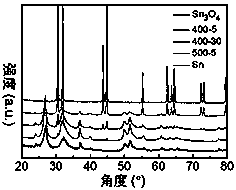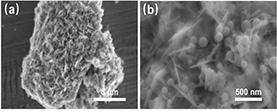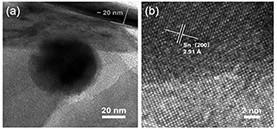Tin-nanoparticle modified oxygenated vacancy tin trioxide nanosheet composite photocatalytic material and preparation method
A technology of tritin tetroxide and composite photocatalysis, which is applied in the direction of metal/metal oxide/metal hydroxide catalyst, chemical instrument and method, physical/chemical process catalyst, etc., to achieve simple method, wide application, and increase light energy The effect of utilization
- Summary
- Abstract
- Description
- Claims
- Application Information
AI Technical Summary
Problems solved by technology
Method used
Image
Examples
Embodiment 1
[0026] ①Weigh 5mM stannous chloride dihydrate (SnCl 2 ·2H 2 O, 1.128 g), 12.5 mM sodium citrate dihydrate (Na 3 C 6 H 5 O 7 ·2H 2 O, 3.6367g) was dissolved in 12.5ml of deionized water, stirred for 10min, sonicated for 10min, and then added 12.5ml of an aqueous solution containing 0.2M sodium hydroxide to adjust the pH to 5.5. Then sonicate for 30min, stir for 1h, make it completely dispersed and dissolved;
[0027] ② Transfer the above solution to a 50ml reactor and react at 180°C for 12h;
[0028] 3. After the reaction, the reaction kettle was naturally cooled to room temperature, and the obtained product was washed with deionized water and absolute ethanol for 3 to 5 times, and then placed in a constant temperature blast drying oven for 10 hours at 80 ° C. The obtained pale yellow powder was SnO4 nanosheets;
[0029] 4. Take the tin tetroxide nanosheet powder obtained in the above steps in a quartz boat, then place it in a tube furnace, under a mixed atmosphere of h...
Embodiment 2
[0031] ①Weigh 5mM stannous chloride dihydrate (SnCl 2 ·2H 2 O, 1.128 g), 12.5 mM sodium citrate dihydrate (Na 3 C 6 H 5 O 7 ·2H 2 O, 3.6367g) was dissolved in 12.5ml of deionized water, stirred for 10min, sonicated for 10min, and then added 12.5ml of an aqueous solution containing 0.2M sodium hydroxide to adjust the pH to 5.5. Then sonicate for 30min, stir for 1h, make it completely dispersed and dissolved;
[0032] ② Transfer the above solution to a 50ml reactor and react at 180°C for 12h;
[0033] 3. After the reaction, the reaction kettle was naturally cooled to room temperature, and the obtained product was washed 3 to 5 times with deionized water and absolute ethanol, respectively, and then placed in a constant temperature blast drying oven for 10 hours at 80 ° C. The obtained pale yellow powder was SnO4 nanosheets;
[0034] 4. Take the tin tetroxide nanosheet powder obtained in the above steps in a quartz boat, then place it in a tube furnace, under a mixed atmos...
Embodiment 3
[0036] ①Weigh 5mM stannous chloride dihydrate (SnCl 2 ·2H 2 O, 1.128 g), 12.5 mM sodium citrate dihydrate (Na 3 C 6 H 5 O 7 ·2H 2O, 3.6367g) was dissolved in 12.5ml of deionized water, stirred for 10min, sonicated for 10min, and then added 12.5ml of an aqueous solution containing 0.2M sodium hydroxide to adjust the pH to 5.5. Then sonicate for 30min, stir for 1h, make it completely dispersed and dissolved;
[0037] ② Transfer the above solution to a 50ml reactor and react at 180°C for 12h;
[0038] 3. After the reaction, the reaction kettle was naturally cooled to room temperature, and the obtained product was washed 3 to 5 times with deionized water and absolute ethanol, respectively, and then placed in a constant temperature blast drying oven for 10 hours at 80 ° C. The obtained pale yellow powder was SnO4 nanosheets;
[0039] 4. Take the tin tetroxide nanosheet powder obtained in the above steps in a quartz boat, then place it in a tube furnace, under a mixed atmosp...
PUM
| Property | Measurement | Unit |
|---|---|---|
| diameter | aaaaa | aaaaa |
| thickness | aaaaa | aaaaa |
| diameter | aaaaa | aaaaa |
Abstract
Description
Claims
Application Information
 Login to View More
Login to View More - Generate Ideas
- Intellectual Property
- Life Sciences
- Materials
- Tech Scout
- Unparalleled Data Quality
- Higher Quality Content
- 60% Fewer Hallucinations
Browse by: Latest US Patents, China's latest patents, Technical Efficacy Thesaurus, Application Domain, Technology Topic, Popular Technical Reports.
© 2025 PatSnap. All rights reserved.Legal|Privacy policy|Modern Slavery Act Transparency Statement|Sitemap|About US| Contact US: help@patsnap.com



